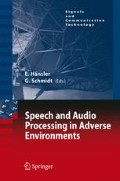In this chapter an introduction on bandwidth extension of telephony speech is given. It is presented why current telephone networks apply a limiting bandpass, what kind of bandpass is used, and what can be done to (re)increase the bandwidth on the receiver side without changing the transmission system. Therefore, several approaches – most of them based on the source-filter model for speech generation – are discussed. The task of bandwidth extension algorithms that make use of this model can be divided into two subtasks: excitation signal extension and wideband envelope estimation. Different methods like non-linear processing, the use of signal and noise generators, or modulation approaches on the one hand and codebook approaches, linear mapping schemes or neural networks on the other hand, are presented.
Access this chapter
Tax calculation will be finalised at checkout
Purchases are for personal use only
Preview
Unable to display preview. Download preview PDF.
References
ANSI S3.2-1989: Method for measuring the intelligibility of speech over communication systems, American National Standard, 1989.
The New Bell Telephone, Sci. Am., 37(1), 1, 1877.
I. N. Bronstein, K. A. Semendjajew: Handbook of Mathematics, Berlin, Germany: Springer, 2004.
M. Buck, H.-J. Köpf, T. Haulick: Lombard-Sprache für Kfz-Anwendungen: eine Analyse verschiedener Aufnahmekonzepte, Proc. DAGA ’06, Braunschweig, Germany, 2006 (in German).
H. Carl, U. Heute: Bandwidth enhancement of narrow-band speech signals, Proc. EUSIPCO ’94, 2, 1178–1181, Edinburgh, Scotland, U.K., 1994.
H. Carl: Untersuchung verschiedener Methoden der Sprachcodierung und eine Anwendung zur Bandbreitenvergrößerung von Schmalband-Sprachsignalen, PhD thesis, Ruhr-Universität Bochum, 1994 (in German).
M. G. Croll: Sound quality improvement of broadcast telephone calls, BBC Research Report, RD1972/26, British Broadcasting Corporation, 1972.
J. Deller, J. Hansen, J. Proakis: Discrete-Time Processing of Speech Signals, Piscataway, NJ, USA: IEEE Press, 2000.
M. Dietrich: Performance and implementation of a robust ADPCM algorithm for wideband speech coding with 64 kbit/s, Proc. Int. Zürich Seminar Digital Communications, 1984.
J. Durbin: The fitting of time series models, Rev. Int. Stat. Inst., 28, 233–244, 1960.
ETSI: Digital cellular telecommunications system (phase 2+); Enhanced full rate (EFR) speech transcoding, ETSI EN 300 726 V8.0.1, Nov. 2000.
J. A. Fuemmeler, R. C. Hardie, W. R. Gardner. Techniques for the regeneration of wideband speech from narrowband speech. EURASIP J. Appl. Signal. Process., 2001(4), 266–274, 2001.
B. Gold, N. Morgan: Speech and Audio Signal Processing, New York, NY, USA: Wiley, 2000.
R. Gray, A. Buzo, A. Gray Jr., Y. Matsuyama: Distortion measures for speech processing, IEEE Trans. Acoust., Speech, Signal Processing, ASSP-28(4), 367–376, Aug. 1980.
H. Gustafsson, I. Claesson, U. Lindgren: Speech bandwidth extension Proc. ICME ’01, 206–209, Tokyo, Japan, 2001.
W. Hess: Pitch Determination of SPeech Signals, Berlin, Germany: Springer, 1983.
B. Iser, G. Schmidt: Neural networks versus codebooks in an application for bandwidth extension of speech signals, Proc. EUROSPEECH ’03, 1, 565–568, Geneva, Switzerland, 2003.
B. Iser, W. Minker, G. Schmidt: Bandwidth Extension of Speech Signals, Berlin, Germany: Springer, 2008.
IPA: The principles of the International Phonetic Association (IPA), being a description of the International Phonetic Alphabet and the manner of using it, illustrated by texts in 51 languages, University College, Department of Phonetics, London, 1949.
ITU: General performance objectives applicable to all modern international circuits and national extension circuits, ITU-T recommendation G.151, 1988.
ITU: 7 kHz audio coding within 64 kbit/s, ITU-T recommendation G.722, 1988.
ITU: Methods for subjective determination of transmission quality, ITU-T recommendation P.800, August 1996.
F. Itakura: Line spectral representation of linear prediction coefficients of speech signals, JASA, 57(1), 1975.
P. Jax: Enhancement of Bandlimited Speech Signals: Algorithms and Theoretical Bounds, PhD thesis, RWTH Aachen, 2002.
P. Jax, P. Vary: On artificial bandwidth extension of telephone speech, Signal Processing, 83(8), 1707–1719, August 2003.
K. D. Kammeyer: Nachrichtenübertragung, Stuttgart, Germany: Teubner, 1992 (in German).
U. Kornagel: Spectral widening of telephone speech using an extended classification approach, Proc. EUSIPCO ’02, 2, 339–342, Toulouse, France, 2002.
U. Kornagel: Synthetische Spektralerweiterung von Telefonsprache, PhD thesis, Forschritt-Berichte VDI, 10(736), Düsseldorf, Germany, 2004 (in German).
W. P. LeBlanc, B. Bhattacharya, S. A. Mahmoud, V. Cuperman: Efficient search and design procedures for robust multi-stage VQ of LPC parameters for 4 kb/s speech coding, IEEE Transactions on Speech and Audio Processing, 1(4), 373-385, October 1993.
N. Levinson: The Wiener RMS error criterion in filter design and prediction, J. Math. Phys., 25, 261–268, 1947.
Y. Linde, A. Buzo, R. M. Gray: An algorithm for vector quantizer design, IEEE Trans. Comm., COM-28(1), 84–95, Jan. 1980.
D. G. Luenberger: Opitmization by Vector Space Methods, New Yory, NY, USA: Wiley, 1969.
A. V. Oppenheim, R. W. Schafer: Discrete-Time Signal Processing, Englewood Cliffs, NJ, USA: Prentice Hall, 1989.
K. K. Paliwal, B. S. Atal: Efficient vector quantization of LPC parameters at 24 bits/frame, IEEE Transactions on Speech and Audio Processing, 1(1), 3-14, January 1993.
P. J. Patrick: Enhancement of Bandlimited Speech Signals, PhD thesis, Loughborough University of Techology, 1983.
J. Paulus: Variable rate wideband speech coding using perceptually motivated thresholds, Proc. of IEEE Workshop on Speech Coding, 35–36, Annapolis, MD, USA, 1995.
L. Rabiner, R. W. Schafer: Digital Processing of Speech Signals, Englewood Cliffs, NJ, USA: Prentice Hall, 1978.
L. Rabiner, B. H. Juang: Fundamentals of Speech Recognition, Englewood Cliffs, NJ, USA: Prentice Hall, 1993.
H. W. Schüsssler: Digitale Signalverarbeitung 1, 4th edition, Berlin, Germany: Springer, 1994 (in German).
F. K. Soong, B.-H. Juang: Optimal quantization of LSP parameters, IEEE Transactions on Speech and Audio Processing, 1(1), 15-24, January 1993.
P. Vary, R. Martin: Digital Speech Transmission: Enhancement, Coding and Error Concealment, New York, NY, USA: Wiley, 2006.
W. Voiers: Evaluating processed speech using the diagnostic rhyme test, Speech Technology, 30–39, Jan./Feb. 1983.
Author information
Authors and Affiliations
Editor information
Editors and Affiliations
Rights and permissions
Copyright information
© 2008 Springer-Verlag Berlin Heidelberg
About this chapter
Cite this chapter
Iser, B., Schmidt, G. (2008). Bandwidth Extension of Telephony Speech. In: Hänsler, E., Schmidt, G. (eds) Speech and Audio Processing in Adverse Environments. Signals and Communication Technology. Springer, Berlin, Heidelberg. https://doi.org/10.1007/978-3-540-70602-1_5
Download citation
DOI: https://doi.org/10.1007/978-3-540-70602-1_5
Publisher Name: Springer, Berlin, Heidelberg
Print ISBN: 978-3-540-70601-4
Online ISBN: 978-3-540-70602-1
eBook Packages: EngineeringEngineering (R0)

